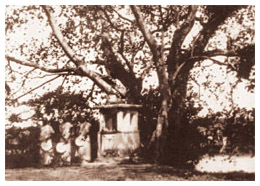History of the Kalutara Bodhi
It is believed that the Bōdhi Tree at Kalutara sprouted from a sapling of the Jaya Sri Maha Bōdhi (The Great Resplendent Fig Tree Symbolising Victory) in Anuradhapura, which itself is a sapling of the very Bōdhi Tree (Ficus religiosa) in Bihar, in Madhya Pradesh, India. It is underneath this tree that the Buddha attained enlightenment.


The history of the tree is a fascinating one. This is the story of a fig tree at Buddha Gaya, which became a subject of veneration after Prince Siddhartha Gautama attained enlightenment or Buddhahood while seated in absorption and meditation under its spreading branches. Centuries later the tree became a ‘symbol of the Buddha’s presence and an object of worship’. The site became a shrine even during the Buddha’s lifetime. In later years, Emperor Dhammasoka held an annual festival in its honour, showed devotion and paid attention to the tree. This aroused the resentment of one of his queens, Tissarakkha, who three years after she became the queen, in the nineteenth year of his reign, caused the original tree to be killed by sticking ‘mandu’ thorns into the bark. It sprouted again and a monastery by the name of Bōdhimanda Vihara was built there.
“The original at Bodh Gaya was destroyed by King Puspyamitra during his persecution of Buddhism in the 2nd century BC and the tree planted to replace it, probably an offspring, was destroyed by King Sassanka at the beginning of the 7th century CE. The tree that grows at Bodh Gaya today was planted in 1881 by a British archaeologist after the previous one had died of old age a few years before. Many temples throughout the Buddhist world have Bōdhi trees growing in them which are, or are believed to be offspring of the one from Anuradapura and their worship forms an important part of popular Buddhist piety.” B.M. Barua, Gaya and Bodh Gaya. Calcutta, Vol. I, 1931, Vol II, 1934.

A sapling of the original tree was brought to Sri Lanka by Theri Sanghamitta, daughter of the Indian Emperor Dhammasoka and twin sister of the Venerable Mahinda Mahā Thera. She journeyed through Pātāliputta, on to Tāmalitti and then on to Jambukola in the extreme North of Sri Lanka with a stop in Tivakka. This sapling was planted in the Mahamevna Park in Anuradhapura in 288 CE. As the original tree at Bihār was destroyed, it is a historical fact that the Sri Maha Bōdhi or the Great Resplendent Bōdhi Tree at Anuradhapura is the world’s oldest and the only tree with a documented history. The history of the Bōdhi tree is recorded in the classical Bōdhi Vansa (The book on the History of the Bōdhi Tree). It states that the sapling bore Ashta Phala or eight fruits. Out of these, four issued forth from each fruit, making up a total of 32 saplings. The Venerable Maha Mahinda Thera himself had specified the places where each of these saplings should be planted. The Bōdhi Vansa records each and every such place. The list is as follows:

- 01. Malwessa Vehera
- 02. Tantrimala Vehera
- 03. Mahajallika gama
- 04. Kottiyarama
- 05. Polonnaruwa
- 06. Matale Ruseegama
- 07. Ruhunu Rata Magama
- 08. Wilvala
- 09. Mahiyanganaya
- 10. Seruvila Wilgama Vehera
- 11. Badulle Mutiyanganaya
- 12. Buttala Happoru Vehera
- 13. RuhunuRata Situlpahu Vehera
- 14. Wanawasa Vehera Tangalle
- 15. Weligam Vehera
- 16. Paragoda
- 17. Meddegama
- 18. Ganegama
- 19. Kotmale Pusulpitiya
- 20. Maya Rata– Wathura
- 21. Beligala
- 22. Bellanvila
- 23. Wandurawa
- 24. Wattarame Raja Maha Viharaya
- 25. Sulugalle
- 26. Resvehera
- 27. Katiyawa
- 28. Giriba Vehera
- 29. Yapahu Sundaragiri Pawwa
- 30. Kasagalu Vehera
- 31. Embalawa
- 32. Ratgal Vehera
